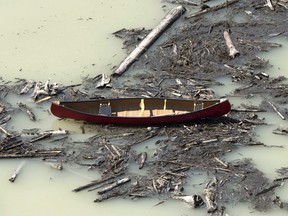Nikki Skuce and Christine McLean: B.C. yet to follow Mount Polley recommendation toward zero failures
Opinion: B.C. must plan for the cumulative risks of mine waste dams, including the impacts of extreme weather that make these sites increasingly vulnerable to destabilization

Article content
Aug. 4 marks eight years since the worst mining disaster in Canadian history, the Mount Polley tailings dam collapse, which sent 25 million cubic metres of toxic wastewater and tailings crashing into the Quesnel Lake watershed. Despite some regulatory and enforcement improvements, B.C. has yet to reduce the number and volume of mine tailings facilities in the province to mitigate the likelihood of future disasters.
The Mount Polley mine is expected to fully reopen this summer. Recent research has shown that the contamination from the 2014 disaster is still affecting organisms at the base of the food chain and working its way up to wild salmon and bears, with the potential to impact fisheries and humans. The researchers said it would be “an impossible task” to remove all the contamination. No one else should have to live through a similar disaster where your drinking water is polluted.
The expert panel formed to investigate the Mount Polley disaster recommended that B.C. reduce the number of tailings facilities by half in order to get toward a path to zero failures. This recommendation has not been heeded. Rather, recently proposed mines would have some of the tallest tailings dams in the world — some as high as Vancouver’s tallest skyscraper, the Shangri-La Tower — adding to the already massive amount of mine waste in the province.
Mining metals and minerals generates large volumes of solid wastes, amounting to tens of million of tons every year in B.C. Much of this waste is toxic and can contaminate entire watersheds if not contained properly or if the engineered structures fail, like in the case of Mount Polley.
The B.C. government and mining proponents will tell you that mines follow strong safety standards and that the province’s laws and regulations have and continue to be updated to ensure the safety of tailings facilities. Important reform processes happened after the Mount Polley mine dam breach and additional improvements are needed to put safety first and avoid amendment loopholes that are known to impact water quality and quantity.
But the larger issue is the cumulative risk of having 172 tailings facilities in B.C., at 75 mine sites. With climate change-related extreme weather events and B.C.’s seismicity, any of these sites are increasingly vulnerable to flooding and destabilization in ways that even the best engineers and government officials cannot foresee. Catastrophic flooding events, typically seen only once in 100 years, have become regular events in B.C. and have the potential to overwhelm or destabilize tailings storage facilities in high rainfall areas, which is a major cause of dam failures globally.
Recent research and an interactive online map by the B.C. Mining Law Reform network and SkeenaWild Conservation Trust show that a failure at nearly half of the tailings sites would result in serious impacts to communities, watersheds, and all the lives and livelihoods that depend on them.
Industry and investors increasingly recognize the need to reduce the volume of tailings waste at operating mines while also advancing safe closure and reclamation at tailings facilities in care and maintenance. Unfortunately, B.C. does not have a plan to deal with this legacy of waste — just a plan to grow the problem.
As the Mount Polley Expert Panel stated: “Simply put, dam failures are reduced by reducing the number of dams that can fail.”
With the increasing need for minerals for EV cars and renewable energy, we all want B.C. to be a leader in responsible mining — while also finding solutions to recycle and reuse existing minerals as much as possible. To do this, B.C. must consider the cumulative risks and make concrete plans to reduce the volume of toxic mine waste that sits upstream from communities and watersheds. We need to get on the path to zero failures and reduce the likelihood of another disaster like Mount Polley, a toxic legacy that continues today.
Nikki Skuce is the co-chair of the B.C. Mining Law Reform network based out of Smithers; Christine McLean is a member of the Concerned Citizens of Quesnel Lake.










Postmedia is committed to maintaining a lively but civil forum for discussion. Please keep comments relevant and respectful. Comments may take up to an hour to appear on the site. You will receive an email if there is a reply to your comment, an update to a thread you follow or if a user you follow comments. Visit our Community Guidelines for more information.